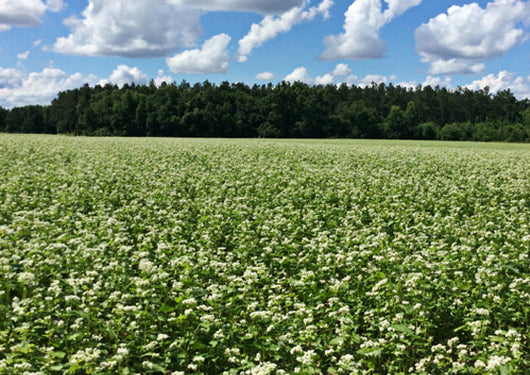
We encourage you try Buckwheat this summer to build your soil and enhance the growth of your summer cover or forage crop. Even though it is not high on the forage preference list for wildlife and livestock, it does greatly enhance the growth of the forages it is planted with. It promotes faster and healthier growth of Sunn Hemp, cowpeas, pearl millet, sorghum sudan and other summer crops that it is planted with.
Click the “size” box to choose different weights of bags available for this product!
 Order Online or Call (251) 827-6594
Order Online or Call (251) 827-6594
The benefits of buckwheat are many: It’s quick growth gives rapid cover, helps suppress weeds, attracts beneficial insects and it’s an excellent nectar producer for honey bees. Its abundant, fine roots are excellent for soil building. The roots also produce mild acids, which dissolve the the phosphorus and calcium in the soil, making it available for the plants planted alongside it. Buckwheat also produces two to three tons of dry matter per acre, which decomposes quickly and releases nutrients. Just adding 10 pounds per acre will benefit every plant it grows alongside.
It also works as food for human beings, especially for those who require gluten-free options. It makes for excellent pancakes!
Buckwheat prefers light to medium, well-drained soil. Ideal pH is between 5.0 and 7.0. The seed is best planted after the last frost, between April and September, at a depth of 1/2” to 1.5”. It’s a great nutrient scavenger, and requires very little fertilization. It will grow fast, the quickest of all cover crops, growing and flowering in 18 to 20 days. It will make seed by Day 60, growing to two or three feet tall. You can get another crop going once the seed matures. Lightly till the soil and your next crop will come up. Fall frost will kill the Buckwheat.
Sunn hemp and buckwheat may be an excellent cover crop. Presently at Petcher Seeds, we are studying this cover crop mix which appears to be outstanding as a cover crop, wildlife food plot, and for bees. The reason for using buckwheat in the mix is that it adds so many benefits. Sunn hemp, being a legume, provides 100 lbs. of Nitrogen, about 10 lbs. of Phosphorus, and 80 lbs. of Potash in 60 days. The major missing soil nutrient that it doesn’t provide is Phosphorus. Buckwheat is one of the few plants in the world whose roots are so acidic that they dissolve the Phosphorus in the soil and make it available for the next plant crops use. Sunn hemp and buckwheat seed are very similar in size. A suggested planting rate is 10 lbs. of each per acre. Both plants germinate and grow quickly. The buckwheat actually grows a little faster than the sunn hemp. At day 45 after planting, the buckwheat is ahead of the sunn hemp as shown in photo above. The buckwheat will start blooming even as early as day 18, and by day 45 it will have totally bloomed and soon start to die. Then the sunn hemp will then take over. The major impact of this mix is that it will provide all 3 major plant nutrients for the next crop - Nitrogen, Potash, and Phosphorus. Buckwheat and sunn hemp will also increase the amount of organic matter added to the soil.
A major benefit of the buckwheat having a head start on the sunn hemp is that the deer will likely graze on the buckwheat and leave the sunn hemp alone until it has a better chance to get established. Deer, turkey, quail, dove, rabbits, honey bees, and other wildlife and some livestock thrive on buckwheat and sunn hemp.
Here’s what you can expect when you plant Petcher Seeds’ Buckwheat.

Scientific Name:
Fagopyrum esculentum

Seed Count:
13,000 seed / LB.

Seasons:
Buckwheat can be planted from April through September.

Planting Rate:
50 to 70 LBs. / acre, 10 LBs. in a mix
You may try 10 lbs. of Buckwheat planted with 20 lbs. of our AU Golden Sunn Hemp. The Buckwheat starts blooming in about three weeks and will bloom for another three to four weeks. The AU Golden will start blooming then and will bloom for another five to six weeks. This will provide a rather long nectar source for your Honey Bees. In our test plots, the forages planted with Buckwheat outperformed the ones without it.


 Newsletter
Newsletter
 Contact
Contact
 My cart (0)
My cart (0)

















 Have a question?
Have a question?